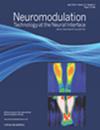Electrical Diuretics: Lateral Epidural Stimulation of Dorsal Roots to Increase Diuresis
IF 3.2
3区 医学
Q2 CLINICAL NEUROLOGY
引用次数: 0
Abstract
Background
Stimulating diuresis is crucial in heart failure (HF) treatment. Diuretic resistance develops in approximately 30% to 45% of patients with HF.
Objective
We investigated the feasibility and safety of lateral epidural stimulation (LES) to enhance diuresis by stimulating renal afferent sensory nerves.
Materials and Methods
In 16 pigs, volume overload with elevated and stable pressures was induced. Diuresis was measured during cycles of up to two hours, and glomerular filtration rate (GFR) was assessed in 12 of 16 experiments. The most effective vertebrae stimulation level was established first. T11–T12 stimulation effectiveness was tested, using a high current (1.2 mA) in one animal and relatively low currents (0.1–0.3 mA) in 15 animals. In three animals, LES effects were assessed during furosemide infusion.
Results
T11–T12 was the most effective vertebrae level for LES. Diuresis increased from 18 mL/20 min (SD = 4 mL/20 min) to 47 mL/20 min (SD = 32 mL/20 min) (n = 9, p < 0.0001), and GFR increased on average 44 [mL/min] (SD = 26, n = 6) (p < 0.001) during T11–T12 LES compared with baseline, excluding one experiment with high current and three lead misplacements. Negative effects in these excluded cases were, according to necroscopy, related to ventral root stimulation, causing shivering, muscle contractions, and elevated heart rate. LES enhanced diuresis during a continuous infusion of furosemide by 54% and 149% and GFR increased by 16 and 14 [mL/min] (two/three correct lead placement).
Conclusion
LES at T11–T12 could rival the effectiveness of long-term HF diuretics. Unlike furosemide, LES positively affected kidney function.
电利尿剂:侧侧硬膜外刺激脊背根以增加利尿
背景:刺激利尿在心力衰竭(HF)治疗中至关重要。约30% - 45%的心衰患者出现利尿剂耐药。目的探讨外侧硬膜外刺激(LES)通过刺激肾传入感觉神经来增强利尿的可行性和安全性。材料与方法对16头猪进行高压力和稳定压力诱导的体积过载试验。在长达2小时的周期内测量利尿,并在16个实验中评估12个肾小球滤过率(GFR)。首先确定了最有效的椎体刺激水平。测试了T11-T12刺激的有效性,在一只动物身上使用高电流(1.2 mA),在15只动物身上使用相对低电流(0.1-0.3 mA)。在三只动物中,评估了速尿输注期间的LES效应。结果st11 - t12是治疗LES最有效的椎体水平。利尿从18 mL/20 min (SD = 4 mL/20 min)增加到47 mL/20 min (SD = 32 mL/20 min) (n = 9, p <;0.0001), GFR平均升高44 [mL/min] (SD = 26, n = 6) (p <;0.001)在T11-T12 LES期间与基线相比,不包括一个大电流和三个引线错位的实验。在这些被排除的病例中,根据坏死镜检查,负面影响与腹侧神经根刺激有关,引起发抖、肌肉收缩和心率升高。连续输注速尿时,LES使利尿作用增强了54%和149%,GFR增加了16和14 [mL/min](2 / 3次正确导联放置)。结论T11-T12的les可与长期HF利尿剂的疗效相媲美。与速尿不同,LES对肾功能有积极影响。
本文章由计算机程序翻译,如有差异,请以英文原文为准。
求助全文
约1分钟内获得全文
求助全文
来源期刊

Neuromodulation
医学-临床神经学
CiteScore
6.40
自引率
3.60%
发文量
978
审稿时长
54 days
期刊介绍:
Neuromodulation: Technology at the Neural Interface is the preeminent journal in the area of neuromodulation, providing our readership with the state of the art clinical, translational, and basic science research in the field. For clinicians, engineers, scientists and members of the biotechnology industry alike, Neuromodulation provides timely and rigorously peer-reviewed articles on the technology, science, and clinical application of devices that interface with the nervous system to treat disease and improve function.
 求助内容:
求助内容: 应助结果提醒方式:
应助结果提醒方式:


